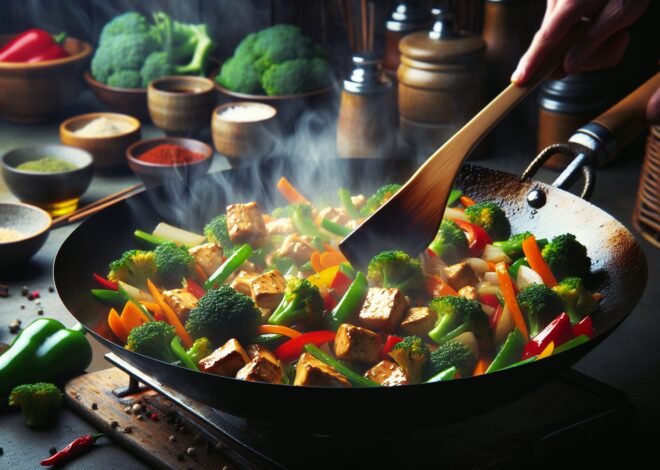
How to Cook Stir-Fry with Minimal Oil for a Healthier Dish
Stir-fry with minimal oil is a healthier way to enjoy quick and flavorful meals without sacrificing taste. Did you know that using less oil can significantly reduce calories in your dish while still retaining rich flavors? This post will guide you through techniques to cook stir-fry with minimal oil, emphasizing fresh ingredients, proper cooking methods, and seasoning to enhance taste. By the end, you’ll discover easy adjustments that make your meal both nutritious and delicious. Dive in to find practical tips and tricks for a guilt-free stir-fry experience.
Benefits of Cooking Stir-Fry with Minimal Oil for Healthier Meals
Cooking stir-fry with minimal oil offers numerous health benefits. It’s not just about cutting calories; it’s about enhancing the nutritional value of your meals. By using less oil, you can improve heart health, manage weight more effectively, and enjoy a more nutrient-rich dish. Let’s explore how cooking with minimal oil can transform your stir-fry into a healthier meal option.
Nutritional Advantages of Low-Oil Stir-Fry Techniques
Low-oil stir-fry techniques preserve the natural flavors and nutrients of your ingredients. Cooking with less oil means that vegetables retain their vibrant colors and essential vitamins. This method also prevents the degradation of healthy fats found naturally in some foods. Using minimal oil allows you to highlight fresh ingredients’ natural taste, making each bite satisfying and nourishing.
How Reducing Oil Can Boost Heart Health
Heart health is significantly influenced by dietary choices, and reducing oil in your stir-fry is a step towards a healthier heart. Excessive oil consumption can lead to increased cholesterol levels, which is a risk factor for heart disease. Opting for minimal oil helps maintain healthy cholesterol levels, supporting cardiovascular function. It’s a simple change that can lead to long-term heart health benefits.
Caloric Reduction and Weight Management with Less Oil
Using less oil in your stir-fry is an effective way to cut down on calories without sacrificing taste. Each tablespoon of oil adds roughly 120 calories, which can add up quickly. By minimizing oil usage, you can enjoy flavorful meals that are lower in calories, aiding in weight management. This approach helps you achieve your fitness goals while still enjoying delicious food.
Essential Tips for Creating Delicious Stir-Fry with Minimal Oil
Creating a delicious stir-fry with minimal oil is easier than you might think. With the right techniques and tools, you can achieve the perfect balance of flavor and texture. This section will provide practical tips to enhance your stir-fry game, ensuring that every dish is both healthy and tasty without the need for excessive oil.
Using Non-Stick Cookware for Oil-Less Cooking
Non-stick cookware is a game-changer for low-oil stir-fry cooking. It allows food to cook evenly without sticking, reducing the need for added oil. This type of cookware ensures that your ingredients are cooked to perfection, enhancing the overall dish quality. Investing in a good non-stick pan can make a significant difference in your cooking experience.
Advantages of Non-Stick Cookware
- Prevents sticking and burning
- Requires less oil or butter
- Makes cleanup easier and quicker
Techniques for Achieving Flavors Without Excessive Oil
Maximizing flavor without excessive oil is all about using the right techniques. Infuse your stir-fry with herbs, spices, and natural seasonings to enhance taste. Sauté garlic and onions at the start to lay a flavor foundation. Consider deglazing the pan with broth or vinegar to add depth. These methods ensure a flavorful dish that doesn’t rely on oil for taste.
Adjusting Cooking Times for Optimal Texture and Taste
Cooking times can greatly impact the texture and flavor of your stir-fry. To achieve optimal results, cook dense vegetables like carrots and broccoli first. Follow with softer vegetables such as bell peppers and zucchini. Adjusting cooking times allows each ingredient to retain its unique texture and flavor, resulting in a balanced and delicious stir-fry.
Best Ingredients and Alternatives for a Low-Oil Stir-Fry
Choosing the right ingredients and alternatives is key to a successful low-oil stir-fry. Incorporating fresh vegetables, lean proteins, and natural substitutes for oil can elevate your dish. This section will guide you through selecting ingredients that enhance flavor and nutrition, turning your stir-fry into a wholesome meal.
Choosing Fresh Vegetables and Proteins for a Healthier Dish
Fresh vegetables and proteins are the foundation of a healthy stir-fry. Opt for seasonal vegetables to ensure maximum flavor and nutrients. Choose lean proteins like chicken breast or shrimp to keep the dish light. Freshness matters, as it enhances taste and provides essential vitamins that contribute to a balanced diet.
Top Vegetables for Stir-Fry
- Broccoli
- Bell peppers
- Snap peas
- Carrots
Using Broths and Natural Seasonings as Oil Substitutes
Broths and natural seasonings are excellent oil substitutes that add flavor without extra calories. Vegetable or chicken broth can be used to steam ingredients, adding a light yet rich taste. Natural seasonings like ginger, garlic, and herbs also play a crucial role in enhancing flavor. These alternatives provide a healthier way to enjoy your stir-fry.
Incorporating Tofu and Lean Meats to Enhance Nutrition
Tofu and lean meats are great additions to a low-oil stir-fry. Tofu offers a plant-based protein option that’s low in calories. When paired with lean meats like turkey or fish, it creates a balanced protein profile. These options not only enhance nutrition but also provide versatility in flavor and texture, making your stir-fry a satisfying meal.
Conclusion
Stir-frying with minimal oil is a healthier cooking method that retains the flavor and nutrients of ingredients. It involves using a non-stick pan to reduce the amount of oil needed. Ingredients should be cut into uniform sizes to ensure even cooking. High heat is essential to prevent food from sticking and to achieve a crispy texture. Adding a small amount of water can help create steam and further reduce the need for oil.
FAQ
How can I make a healthy stir-fry using minimal oil?
Use a non-stick pan or wok to prevent sticking. Opt for a spray bottle to evenly distribute a small amount of oil. Incorporate broth or water to keep ingredients moist and aid in cooking.
What are the best techniques to stir-fry with less oil for a healthier meal?
Preheat your pan well before adding ingredients for an easy release. Cut vegetables uniformly to ensure even cooking. Stir constantly to prevent burning and ensure all pieces get cooked evenly.
Can I achieve a flavorful stir-fry by reducing oil content?
Boost flavor with aromatic ingredients like garlic, ginger, or onions. Use sauces with low sodium or homemade varieties to control flavor without adding excess oil. Adding herbs and spices can also enhance taste.
What types of oil are healthiest for stir-frying with minimal use?
Choose oils with high smoke points like avocado, grapeseed, or canola oil. These options maintain stability at higher temperatures and are heart-healthy choices.
How does using less oil in stir-frying impact the texture and flavor of vegetables?
Vegetables may taste lighter and retain more of their natural flavors. A quick stir-fry with minimal oil helps to preserve their crispness and nutritional value.
What are alternative cooking methods to stir-fry without using oil?
Steaming and sautéing with broth or water can be excellent oil-free options. Use a non-stick pan to prevent ingredients from sticking and keep flavors intact.











